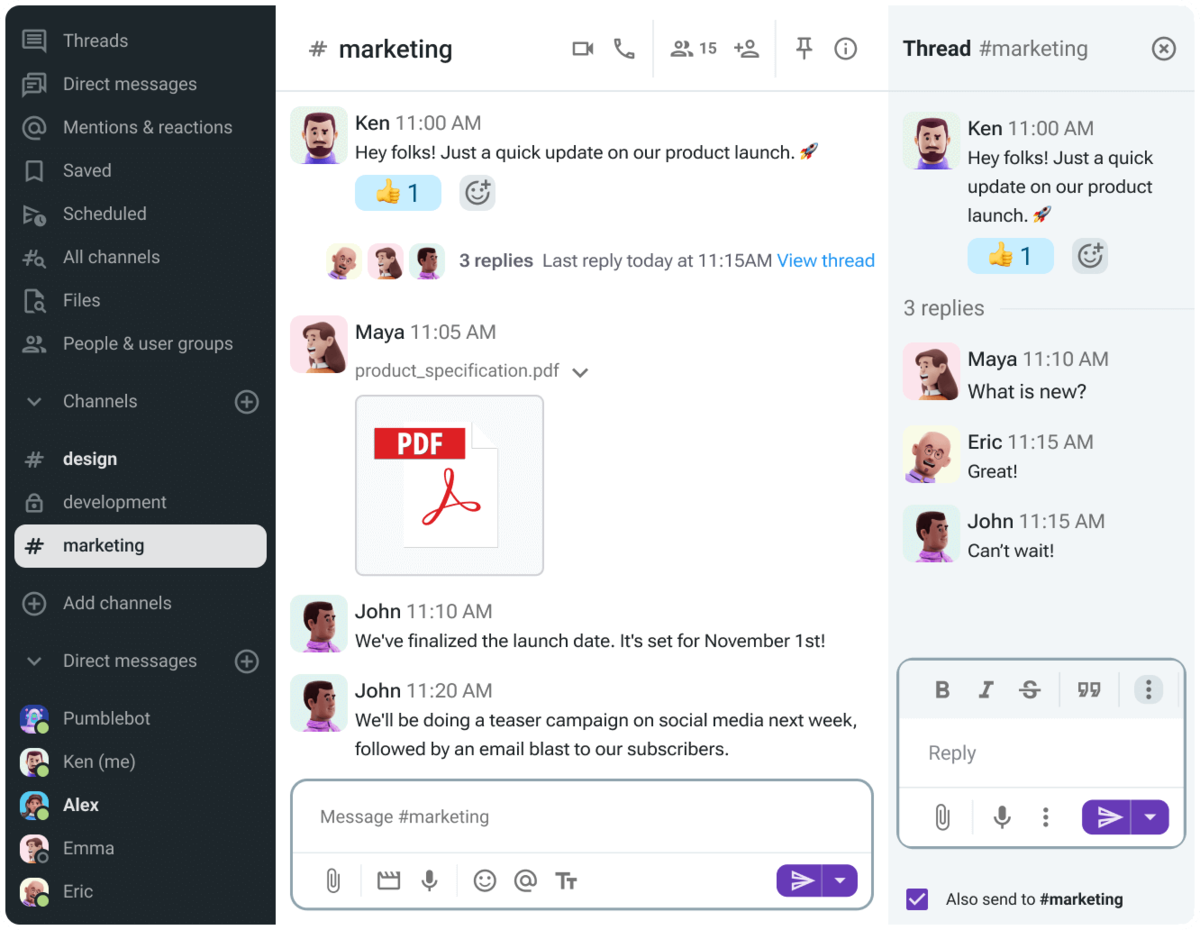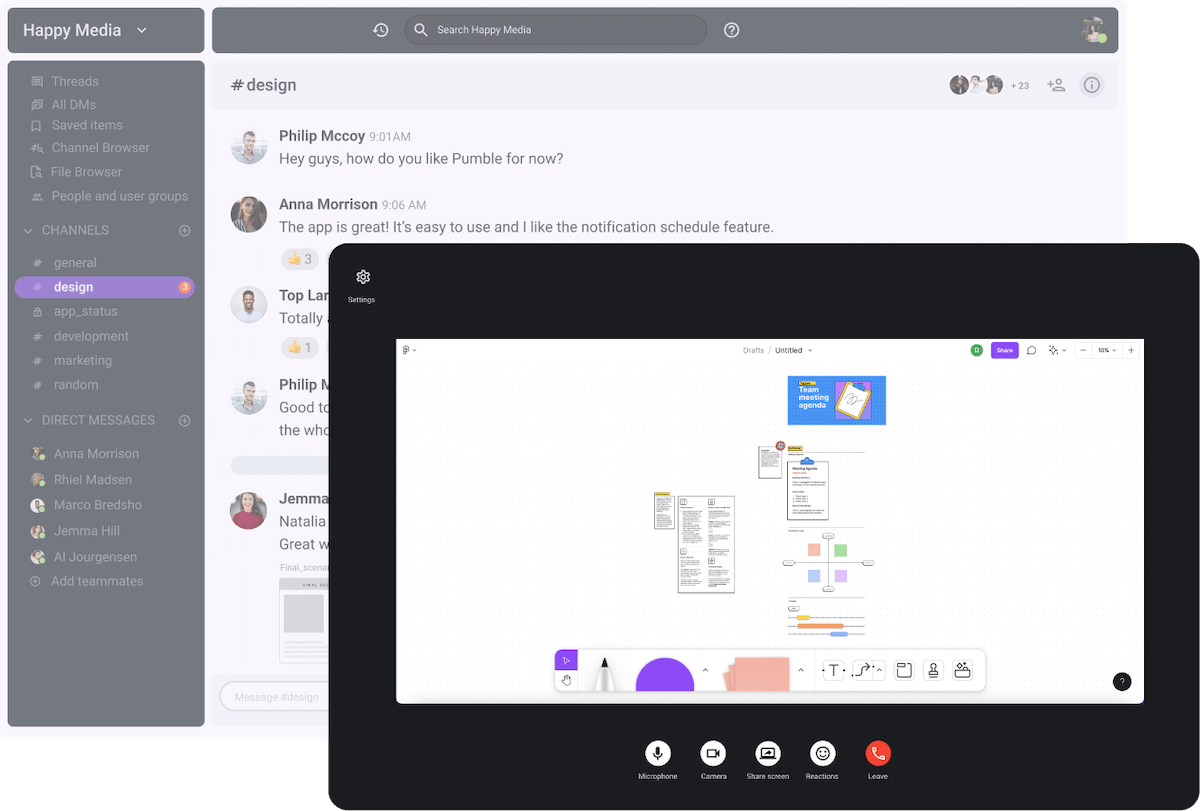Do you have a presentation coming up at work? Is the mere thought of getting up and speaking in front of other people keeping you up at night?
Just imagining the situation where all your colleagues are watching you while you struggle to get through your presentation is enough to get your heart pounding and palms sweating.
Don’t worry, you’re not alone.
In this blog post, we will go over why you feel nervous for presentations, and offer some tips and tricks on how to better manage your nervousness.

Table of Contents
Why do you get nervous before presenting?
If you are nervous before a presentation, you likely have a fear of public speaking.
This is a widespread fear, affecting up to 75% of the population. As Mark Twain once said:
“There are two types of speakers: those who get nervous and those who are liars”.
Of course, some people have it worse than others. In some cases, people can just be a bit nervous, but ultimately be able to get over their fear and speak in front of others.
In other cases, this fear can be debilitating.
The phobia of public speaking is also called glossophobia.
Some of the signs of glossophobia can include:
- Dry mouth,
- Perspiration,
- Nausea,
- Shaky hands,
- Heart palpitations,
- Increased heart rate and blood pressure, and
- Intense anxiety and panic.
People who have this phobia will avoid public speaking at all costs. This can have a negative impact on their quality of life. They can lose out on opportunities, such as good jobs, because of their fear of any kind of public speaking.
For example, people who suffer from extreme glossophobia may quit their job if they get assigned tasks that involve public speaking. Also, they can have meeting anxiety and opt out of meetings if it involves having to speak.
If you suffer from extreme glossophobia, you should reach out for help. Mental health professionals are trained to help people who are suffering from phobias.
Is it normal to be nervous before a presentation?
It’s believed that public speaking is a fear rooted in prehistoric times.
Our ancestors relied on their tribe to survive, and getting rejected from the group meant bad news.
Speaking in front of people opens you up to just that — judgment and rejection.
Here’s what Linda Whiteside, a Licensed Professional Clinical Counselor, has to say about this fear:

“Public speaking is a skill, and just like every skill, once you keep doing it you become better at it, and eventually it becomes second nature.
It is normal for us to be nervous when we are subjected to a task that we are not accustomed to, we tend to become agitated as the act is alien to us. Fear is a natural response. However, if it leads to being unable to perform our activities of daily living, it would be prudent to consult a professional.”
The most dreaded aspect of public speaking is the brain freeze.
This happens when our bodies release stress hormones that affect the brain. The frontal lobe is the part of the brain responsible for memories, and with an influx of stress hormones, it shuts down. This makes us freeze and forget what we were about to say.
The fight or flight response also plays a role.
This response protects us from threats — we can quickly react to danger without thinking about it. This was essential to our survival when we were constantly in danger of predators.
However, in modern times, this response can be engaged in situations that aren’t life-threatening, such as public speaking. This causes the brain to freeze and leaves us panicked.
The fear you feel when speaking in public is a biological response that we cannot control.
However, we can control our reaction to fear and how we deal with it.
How to cope with presentation nerves
Now that you’re aware of the biology behind this fear, let’s look at some of the ways you can manage it.
We’ll go over some tips and tricks on how to cope with your nerves before, during, and after a presentation.
There are some practices you can implement in your life for long-term stress and anxiety management, as well as tips and tricks you can use at that moment.
How to cope with nerves before the presentation
We’ll start with tips on how to better prepare for a presentation and ways to decrease stress and manage anxiety long-term.
Step #1: Reinforce your knowledge
The first step towards an anxiety-free presentation is to be prepared.
Make sure that you completely understand the topic you’re covering by researching as much as possible.
Also, try to think about questions that people could potentially have for you. This way, you will be ready to answer any questions that may arise.
Thoroughly knowing your material will leave you with one less thing to worry about during your presentation.
Step #2: Organize your presentation
Another important step in preparing for a presentation is to be organized.
Make sure to prepare a good slide presentation, with points that you can elaborate on freely. Organize it into distinct sections, and memorize the sequence of your talking points to always know what’s next.
Also, think about the technical details. Get to know your surroundings and the equipment you’ll be using to avoid any mishaps.
If you’re doing a presentation online, clear your desk of any clutter, and remove any distractions.
Taking care of these details will reduce your anxiety and make your presentation flow smoothly.
Step #3: Practice your presentation
Another way to decrease nervousness is to practice your presentation beforehand.
Go over your presentation fully, as if you’re already in front of an audience.
Imagine the audience in front of you, and talk as if they’re there. Although it may feel awkward at first, it will help you feel more comfortable when the day of the presentation comes.
You can stand in front of a mirror to observe your body language and make corrections if needed.
If you’re doing a presentation over a video call, another great tip is to turn on your camera app and practice your presentation this way.
Picturing your audience in front of you while you practice will help you visualize the atmosphere and get you used to the feeling of presenting.
Practicing will also help you locate the weak points of your presentation and correct them.
Perfect your presentation skills on Pumble
Step #4: Breathe/meditate
Breathing exercises and meditation are habits you can implement in your everyday life as a stress relief tool.
Meditation has been proven to decrease stress and anxiety levels, as well as help with other mental health issues. Meditation is an amazing tool to have as a part of your everyday life.
However, if you don’t feel like meditating is for you, you can get some of the benefits from meditation practices such as breathing exercises.
You can do some breathing exercises right before your presentation to calm your nerves and clear your head.
Step #5: Turn nervousness into excitement
Another way to ease nervousness is to rewire your brain to interpret nervousness as excitement.
One way to do this is to learn to differentiate between good and bad anxiety.
Anxiety is there for a good reason — sometimes you need to listen to your gut to get out of a bad situation.
However, if you’re anxious about a presentation at work, you can turn this anxiety into excitement.
For example, you have a big presentation at work tomorrow and your brain is running at full speed with thoughts such as: “I’m so nervous, I’m totally going to mess this up. Everyone is just waiting for me to make a mistake”.
This is the moment you can take control and rephrase your inner thoughts to a positive stance such as:
“I’m excited to show everyone what I’ve been working so hard on. I’ll use all of this energy to deliver a great presentation and my coworkers will be stoked to learn something new”.
This kind of positive thinking goes a long way to make you feel better about yourself.
If you keep this up for a long time, eventually you will rewire your brain to instantly interpret anxiety as excitement.
Step #6: Accept fear
We all experience fear, and we can all choose how we will deal with it.
Rather than trying to fight your fear of public speaking, try accepting it.
Fear is a normal part of life, and while it’s not always comfortable, it can serve as motivation rather than intimidation.
Fighting your fear or denying it altogether will only make it worse.
Instead of saying “I’m scared, and I can’t do this”, try telling yourself:
“I’m scared, and I’m doing it regardless”.
You can be scared and still do it.
Step #7: Avoid coffee
A practical tip for all the nervous people out there — avoid caffeine.
Caffeine is a stimulant, which means it increases your alertness and energy. However, that also means you can get side effects such as:
- Restlessness and shakiness,
- Fast heartbeat,
- Nervousness, and
- Trouble sleeping.
You can see why nerves and caffeine don’t go well together, so avoid coffee before your presentation.
If you generally suffer from anxiety, you should try ditching caffeine altogether, as this can positively impact your anxiety levels.
______
💡 Pumble Pro Tip:
For a more detailed analysis of how to prepare for presentations, take a look at our blog post:
How to cope with nerves during the presentation
You’re on stage now. The show is about to start.
Is there anything you can do to cope with nerves during your presentation? Of course there is.
Here are a few bits of advice on how to stay calm while you’re presenting.
Step #1: Drink water
While you’re talking, always keep some water near you.
When you talk for extended periods, your throat can get sore and dry, and drinking a few sips of water will help.
Also, taking the time to drink water will help you relax and slow down during your presentation.
So, always keep a water bottle at hand.
Step #2: Focus on the topic, not the audience
When you’re on stage, your goal is to pass on knowledge.
Focus on your topic and try not to think about the audience as much. They aren’t thinking about the shirt you chose to wear or the fact that you stumbled over your words during the previous slide.
The audience quickly forgets any mistakes and doesn’t obsess over them like you do.
Furthermore, remember that the majority of the people listening to your presentation would also be nervous while presenting. So, even if you do make a mistake, they will relate to you, rather than judge you.
The bottom line is that they are not here to judge, they’re here to learn.
Step #3: Slow down
When people are nervous, they tend to speed up their speech. This, in turn, makes them run out of breath and get even more nervous, which leads to panic mode.
Learn to talk at a moderate pace. Don’t be afraid to pause if you feel yourself picking up speed. It’s better to have a few seconds of silence than to stumble over your words because you’re talking too fast.
Remember to take deep breaths and try to sound conversational rather than rehearsed.
Step #4: Remember the 3 audience truths
Positive self-talk will boost your confidence — you can practice it in your daily life to get the full benefits.
Positive self-talk includes phrases and mantras that you repeat to yourself to:
- Feel more confident,
- Reduce anxiety, or
- Alter your thought process in any other way that benefits you.
Here are the 3 audience truths that even public speaker experts use to calm their nerves:
- They believe you’re the expert — don’t doubt yourself,
- They want you to succeed — they are on your side, and
- They won’t know when you make a mistake — don’t announce it.
Here’s what Barry Maher, an author and speaker, had to say about public speaking:

“First of all, realize that it’s completely normal to be nervous before a presentation. I’ve been a professional speaker for over 20 years, and I have been nervous before almost every one of them. In fact, if I’m NOT nervous, I’ll try to make myself a bit nervous. It helps get my energy level up.
Second, remember, nobody but you knows what you’re supposed to say. If you say it wrong, they’ll never know. Things go wrong all the time in my sessions. Maybe I’ll make a joke about it, or maybe I’ll just ignore it. Either way, the audience is fine. Your audience wants you to succeed. They’ll only get uncomfortable, if you become uncomfortable.”
Evidently, he shares the same outlook defined in these 3 audience truths.
You can repeat these phrases to yourself before and during your presentation to beat your nerves.
Step #5: Don’t fear pauses
Pauses are a great tool to use when speaking in front of an audience.
A well-timed pause can be used to emphasize your point by giving the audience time to think about what you’ve said.
Also, learn to use pauses as a way to quickly collect yourself and calm down before continuing. A deep breath only takes a few seconds, but it will give you enough time to gather your thoughts.
Pausing is also a way to connect with the audience.
When you pause during a presentation, it gives people time to ask questions and relate to the speaker.
Embrace pauses and use them to your advantage.
Connect with your audience over Pumble
Step #6: Maintain eye contact
Although it may feel daunting, maintaining eye contact with the audience is key to a confident speaking experience.
When you lock eyes with a member of the audience, you build rapport and increase engagement.
It can also be beneficial to pick a couple of people to focus on at a time. This will make you feel like there are fewer people in the room and ease your nervousness.
In a room full of people, it’s easy to get distracted. Maintaining eye contact with individuals will help you concentrate on your presentation.
Good eye contact is also a sign of confidence. If you look people in the eye, they will believe your message and respect you as the authority figure.
Step #7: Practice confident body language
Body language can tell you a lot about a person.
Stand up straight, open your arms, and put on a smile. This will not only make you appear more confident, but it will also make you feel better about yourself.
You can also use a power stance a couple of minutes before your presentation to gain confidence. Power stance is typically associated with:
- Chin tilted upward
- Lifted chest
- Hands on the hips
- Feet hip-width apart
Also, don’t be afraid to use your voice.
Increase the volume of your voice to emphasize key points and to appear more assertive and persuasive.
Another way you can battle nervousness on stage is by moving your body.
You can slowly walk across the stage or use your arms and hands to gesticulate while talking.
Moving around creates visual appeal for your audience and makes them concentrate on your presentation more.
Also, walking around will expend some of that nervous energy in a beneficial way.
However, do be careful when doing this, and move only in deliberate ways to avoid annoying your audience with too much movement.
💡 Pumble Pro Tip:
To learn more about body language and how to improve it during virtual meetings, check out our blog post:
How to cope with nerves after the presentation
You’ve just finished your presentation, but you’re still full of that anxious energy. What can you do to shake it off?
Follow these steps to decompress and relax after the stressful situation.
Step #1: Recognize your achievement
First of all, take a deep breath and congratulate yourself on successfully finishing your presentation.
You deserve the praise you get from your coworkers, friends, and family, but don’t forget to pat yourself on the back as well.
Furthermore, treat yourself to something you enjoy. Go to that restaurant you like, or plan a movie night with loved ones.
Success deserves to be celebrated.
Step #2: Don’t obsess over mistakes
After celebrating your accomplishment, you can self-reflect.
Are you satisfied with your performance, or are there details you can improve upon?
This is the time to think about your presentation and analyze your mistakes to better prepare for your next speaking event.
However, analyzing your mistakes shouldn’t turn into obsessing over them and catastrophizing them in your mind.
Analyze, but don’t obsess!
Step #3: Ask for feedback
As part of your evaluation process, you should also be open to hearing opinions of others.
Ask the members of your audience what they liked and disliked about your presentation, and use it to improve yourself.
Ask trusted, experienced coworkers for their feedback, and don’t take it personally when you receive criticism.
Constructive feedback is paramount to growth.
Step #4: Take your mind off the presentation
When everything is said and done, take a break.
Take your mind off the presentation by enjoying your favorite activities.
You can exercise to release all the pent-up energy or watch a movie to decompress.
Another beneficial tip is to disconnect. This can do wonders for your mental health.
Turn off your work phone and mute your email notifications after work to let your mind rest after the stressful experience.
Should you disclose that you’re feeling nervous?
There is an ongoing debate in the sphere of public speaking on whether you should tell your audience you’re nervous.
On the one hand, people think you shouldn’t mention your nervousness.
It’s believed that you gain nothing from disclosing this and that you risk getting even more anxious. It’s said that once you disclose your nervousness to the audience, they’ll go looking for it and will be more likely to find it.
Furthermore, you’ll make the audience focus on your behavior, rather than the material.
On the other hand, some think it can be beneficial to be honest about your nervousness.
It’s believed that being upfront about your fear will reduce it by having the brain let go of the facade of confidence. A common recommendation is to deliver the admission with a humorous remark, as a way to connect with the audience.
In general, you want to appear confident, so it would probably be best to avoid talking about your nerves. However, in some situations, it may be a good icebreaker.
You need to consider your audience, type of presentation, and other factors, and then decide which approach fits your situation more.
Pumble can help you cope with nervousness before a presentation
As you have seen above, you have to do a few things if you want to cope with nerves before the presentation.
Due to the various communication features it offers, Pumble can help you in a mission of dealing with nervousness.
First, thanks to DMs and channels, you can connect with your colleagues or even professionals from outside of your workspace — thanks to guest access — and check in with them to get some feedback on your ideas or rough presentation drafts.

And don’t worry about losing precious data or messages — everything you write in communication channels will stay there forever, thanks to Pumble’s unlimited message history. So, you can always go back and fetch important messages or files.
Furthermore, you can practice your presentation by scheduling a video conference or audio call with your closest colleagues. They can give you their opinions or simply go over the presentation with you, thanks to the screen sharing option in Pumble.

Finally, if you’re worried about forgetting to mention something during your presentation, you can set reminders to jog your memory and help you not forget anything important.
And remember — nervousness before any public speaking event is completely normal.
But, we ultimately have control over how we deal with our fears. So, deal with them, knowing that Pumble will be there for you every step of the way.







